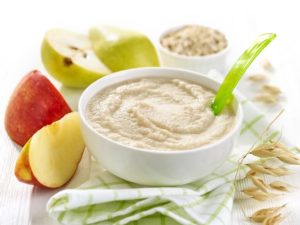Regardless of whether you feed your baby by breast or bottle, there is no way around additional food. It supplements the food supply with vital body components, forms the basis for later complete meals, and supports you during gradual weaning.
You can find out why, what and how you should supplement your baby’s diet in our complementary feeding plan.
Table of contents
Why Breast Milk’s Not Enough In The Long Run
A baby and milk – they go together like white sausage and sweet mustard. But at some point, this one-sided supply is no longer enough. Even if you produce enough milk, don’t want to stop weaning or fill the bottle exactly to the right size, your little one will eventually lack important nutrients.
Before birth, your baby will have built up a few stores that he or she can draw on for many weeks. But when your baby is 4 months old, the stores slowly run out. To make up for the deficit, it needs more. But breast milk can only provide part of the supply, so your baby will have to get some minerals and vitamins from other sources.
That’s what complementary foods are for. It replenishes your baby’s nutrient stores before they are completely empty. In addition, the baby gradually gets used to new tastes and has a new sensory experience: eating.
These Aspects Are Important For The Complementary Feeding Plan
The decreasing memory level is not visible. Or rather, not yet. But if a lack of nutrients is already outwardly apparent, it is all the more difficult to replenish it.
That’s why the complementary feeding plan calls for providing the baby with additional nutrients as early as 4 months after birth – regardless of whether you want to continue breastfeeding, wean or give bottles.
Rely on your midwife or pediatrician for this. They will let you know at the appropriate time that you can “go ahead”.
To do this, the experts pay attention to the so-called tongue stretch reflex, among other things. It should have regressed in a baby around 4 months, so that it can transport food toward the throat.
In addition, your little one must have developed enough muscle strength to sit upright with your help – because lying down makes it difficult for him to swallow the somewhat firmer complimentary food. Even if you express the wish to wean, your midwife or doctor will initially advise you to follow the complementary feeding plan.
A Step-by-step Program That Makes Sense
Your baby has been programmed to eat breast milk since he or she was first breastfed. Substitute products come very close to this food, but the little organism cannot yet process other foods. Only when the immune system is stable enough and enough “good” bacteria have settled in the intestines will the digestive system be able to cope with new foods.
However, if you were to feed your baby large quantities of porridge 4 months after birth, his tummy would be hopelessly overtaxed. The food would come out undigested and could even harm the little one.
A complementary feeding plan is intended to help inexperienced mothers choose the right foods and protect their little ones from health risks. It is not a universal guide. It is impossible to predict how quickly and how well your baby will adapt to the new food.
Our complementary feeding plan is also primarily a recommendation; you must judge for yourself the compatibility of individual products, your child’s willingness to experiment and learn, and your readiness to stop breastfeeding.
Watch Out When Buying Complementary Food! A Morsel Of Great Importance
The first complementary food consists of a single type of fruit or vegetable. Since the taste of breast milk has conditioned your baby to “sweet” for 4 months, the first complementary food should also have a sweet component.
However, flavor is only one criterion for adding a fruit to the complementary feeding schedule. Beyond the sweet taste, it must be.
- Easily digestible.
- Short-fibered.
- Low in starch.
low in starch. These conditions are best met by apple, pear, pumpkin, and carrot. Former exotics such as bananas and potatoes are not yet tolerated by a baby who is under 5 months old. They are only included in the complimentary food plan a little later.
But even the classics of baby food are no guarantee of compatibility. In this respect, the motto is “the proof of the pudding is in the eating”. The important thing is to stick with the chosen variety for the time being – and if possible, to keep the brand.
Eating According To A Complementary Feeding Plan – Not Always The Best Idea
Baby food lives up to its name – because until your baby is 5 months old, it only supplements the menu. Your little one will continue to get the foods he or she is used to.
So it is still being adequately fed. Only from the 6th/7th month does pure milk food become critical, because then the baby’s mineral stores are finally empty. The fact that the complementary feeding plan starts much earlier is to ensure that the baby is used to the food at the time in question.
In principle, it is up to you which meal you enrich first. Most advisors prefer lunch, as it consists of several components and can be put together piece by piece to form a finished meal.
But your baby must be open to new things. If he has a low point at lunchtime of all times, you can also postpone the introduction of complementary foods to another hour of the day.
Start The Complementary Feeding Plan: First Tastes
With his first spoonful of porridge, your baby is not only getting to know a new taste – but also a different way of eating. We think this is too much for the beginning and therefore advise you to start the complementary feeding plan with juice.
It is just as liquid as the previous food and can also be taken in via the teat. Your baby will not have to deal with the mushy consistency or the unfamiliar spoon – but can concentrate entirely on the new taste.
When buying, make sure that it is pure juice without additives such as honey or other fruits! Your baby has had only one food for 4 months and may now take in a second component – but by no means more.
Therefore, give him very little at first. 10-20 ml of single-fruit juice is enough for now; this corresponds to about 1-2 tablespoons. And please keep in mind that your little one’s previous food has always been at body temperature. Even room-warm liquids feel cool in the mouth. If you warm the juice slightly, your baby will certainly accept it better.
If the first attempts with the new taste go wrong, you can also mix the juice with some milk and offer it as a “cocktail”. With a bottle-fed baby, of course, this is easy; as a breastfeeding mother, you would have to spread the breast out a bit.
This small effort can be worthwhile if your darling belongs to the “total refusers” and does not want to make friends with the unknown flavors at all.
If your baby is used to tea, you have another possibility to “untejubeln” him the juice – by mixing it in there. However, this requires that you have chosen a suitable variety. Apple or pear are better suited for this trick than carrot or pumpkin.
Let’s Go On An Adventure! This Is Important For The First Breikost
So far, so good. Once your little one has gotten used to the taste, he or she will soon welcome the juice bottle with joyful waving arms. You can increase the amount from day to day.
However, don’t forget that the complementary feeding plan has its own goal and that you want to wean your little one in the long term. So it’s high time for the next step, a taste of the porridge.
Take the same type of fruit or vegetable that you used for the juice experiment and get a special complimentary food spoon at the drugstore. It is completely flat and made of soft, flexible plastic. This makes it easier for your baby to get used to it and reduces the risk of injury.
Since you will not consume the entire contents of the porridge jar, you should fill the required amount. Again, 1-2 spoonfuls are sufficient at first, which you warm and offer to your baby during a break from drinking. At the beginning of the meal, he is probably too hungry to experiment; after that, just full and tired.
Be firm and purposeful when feeding. If you’re tense or nervous, things will go wrong – because maternal sensations are transmitted to babies in a flash.
Your little one senses when you’re unsure and could ruin your carefully prepared complementary feeding plan. But if he likes the juice, he will recognize the taste and also like the porridge.
The bottle teat, which your baby sucks on and thus also swallows the porridge, helps against problems with the unfamiliar consistency. With a little luck, he or she will happily take another spoonful; otherwise, repeat the procedure with the teat.
Continue with the micro-amounts of porridge until the first week of the complementary feeding plan has passed. Interrupting the drinking process will soon become a habit and you will soon be able to give your little one several spoonfuls in succession.
If there are no intolerance reactions, keep increasing the amount. Keep in mind that the somewhat firmer food is more filling – and your little one will no longer drink his bottle or breast completely. In this way, the complementary feeding plan automatically contributes to weaning.
Complementary Food For Complementary Feeding: Fruit And Vegetable Mixes
As you go along, you may vary your first choice – that is, add a second type of fruit or vegetable.
To do this, you can choose from the range of two-component jars, which combine the “starters” to create new, delicious mixtures and combine carrot with pumpkin, for example.
You can also add another single variety to the complementary feeding plan and offer your little one some spinach or parsnip. These are also well-tolerated varieties, but tasteless sweet – and are therefore usually used in the second step.
If your little one also accepts this porridge, the next step in the complementary feeding plan follows – one of the so-called filling side dishes. Please choose from.
- Potatoes.
- Rice.
- Noodles.
- Semolina.
and delight your baby with his first little menu. If you have started the complementary feeding plan with lunch, hearty combinations such as spinach & potatoes, pumpkin & rice, or similar are suitable. For other times of the day, fruit with baby cookies or rusks are a good choice.
Alternatively Good: Meat Is A Must!
When your baby is 5 months old or older, the complementary feeding plan moves on quickly. Now it is an advantage to have a “midday starter” because the next component is meat. It provides your little one with valuable iron and should therefore become a fixed part of his menu.
Even if you yourself are a vegetarian and/or would like to teach your child this form of nutrition: It is not yet suitable for babies! There are too few alternatives in their diet to meet their nutritional and mineral needs.
You can supplement the complementary feeding plan with individually available meat preparations or buy the first meat-containing menus. In both cases, you should offer your little one a vitamin C-containing drink or dessert after the meal, a juice or fruit porridge, for example. This will help them to better utilize the iron in their food.
In addition, you can now include fish in the complementary feeding plan. There are many ready-made baby menus with salmon or other mild-tasting varieties that are rich in omega-3 fatty acids.
As the menus gradually become more comprehensive, the need for milk continues to decrease. If you are able to implement the complementary feeding plan quickly, your baby will not need any further food for his first complete porridge – an important step towards the planned weaning.
However, additional drinking is all the more important! Every sip of milk that your baby now needs less of must be replaced with tea, water, or other sugar-free drinks. Over the entire complementary feeding plan, your baby’s needs will increase from around 100-150 ml at the beginning to around 400 ml.
A Milestone: Evening Complementary Feeding For Deep Sleep
However, it does not need this amount until further porridges are added. A glance at the jar shelf will give you an idea of what these are: Here, in addition to more complex and varied lunchtime menus, you will also find “evening porridges from the 6th month”.
These are milk and cereal preparations that are intended to replace the bottle in the evening. Instead of this form, you can also buy them as a powder for stirring in or make them yourself using delicately melting cereal flakes. The complementary feeding plan calls for “real” milk because it provides your baby with important proteins and calcium.
It also makes your baby wonderfully tired. You will notice that he [sleeps faster and longer] [https://www.practicalmommy.com/wie-lange-sollten-kinder-schlafen/] as soon as this point in the complementary feeding plan is reached. This also supports you when weaning and provides you with restful breaks.
Final Spurt In The Complementary Feeding Plan: The Two Small Snacks
You need them, too, because your baby is becoming more active during the day. Between the 7th and 9th months, his action radius increases considerably, because he learns to roll, crawl and crawl. To do this, it needs energy, which the complementary feeding plan takes into account with an afternoon meal.
For this purpose, you can choose from the delicious fruit and cereal paps of various suppliers. You can feed them straight from the jar – and enjoy the newfound freedom during long walks. However, make sure that this meal does not contain milk, otherwise, the valuable iron from the fruit-cereal combination will be lost.
The last step on the way to weaning is breakfast: After you have introduced your baby to solid food step by step over 5 months, you may eat your first slice of bread together.
Spread with a little butter, cream cheese or liverwurst, it is the last building block in the complementary feeding plan and now also replaces the morning bottle.













1 thought on “Baby Food Plan: The Optimal Diet For The First Year”